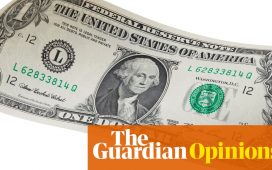This article is an on-site version of our Unhedged newsletter. Sign up here to get the newsletter sent straight to your inbox every weekday
Good morning. The president of Blackstone, Jonathan Gray, has joined big shots including Jamie Dimon and Larry Fink in saying the market is wrong to anticipate rate cuts at the end of this year. More importantly, noted financial journalist Rob Armstrong agrees with them. But in a plot twist, the upstart kid shaking up the comment industry, Ethan Wu, thinks there will be cuts. Let us know which team you are on: robert.armstrong@ft.com and ethan.wu@ft.com.
Margins revisited, redux, again
We have written a lot about profit margins in the past few weeks. Summary: margins were already high, by historical standards, coming into the pandemic. In the post-pandemic boom, they got really, really high. Now they are falling a bit (how much depends on how you measure them). But it seems odd to expect an imminent recession when margins are still so elevated. Tighter margins cause companies to fire workers, so they cause recessions as much as they are caused by them.
One important issue we have not focused on, however, is the relationship between margins and inflation (and therefore monetary policy). Andrew Hunter of Capital Economics is optimistic that, just as the pop in margins pushed inflation significantly higher than it would have otherwise been, a return to normal in margins could be significantly deflationary. He notes that at its peak in the first quarter of last year, retailer and wholesaler mark-ups (“trade services”) accounted for more than a third of PPI consumer inflation (prices producers receive for anything sold to consumers). Here’s a chart of those prices. The difference between the blue and pink lines is, essentially, the effect of higher margins on prices:

This does not, of course, mean that margins are anywhere near back to normal. Looking at the levels of the trade services data, mark-ups are 25 per cent higher than they were in 2019 (this is a slightly wider measure than Hunter uses):

For Hunter, this suggests that there is room for margin compression to take a percentage point or two off inflation in the months to come. “If we’re right that the economy will weaken sharply over the coming months, there is a good chance that profit margins will continue to fall.”
The question of if and when elevated profit margins will fall is important, and not easy (remember that the elevated profitability of US companies that followed the second world war lasted for more than 20 years). So it is worth talking about why margins rose to new highs shortly after the pandemic began.
In a much-circulated recent paper, the economists Isabella Weber and Evan Wasner offer a theory. They argue that supply shocks, like the ones created by the pandemic and the war in Ukraine, provide an opportunity for companies to push through co-ordinated price increases. Normally, fear of losing market share restrains price increases. After a supply shock, though, things are different:
If we think of a firm’s market as a territory surrounded by barriers created by brand identity, commercial infrastructure, customer relations etc, then a supply constraint means being unable to service the totality of one’s own territory. If this is the case for all firms in a sector, the ability of competitors to intrude into the territory of other firms in the short run radically declines . . . This can allow firms to gain temporary monopoly power.
Furthermore, the co-ordinated price increases enabled by supply shocks can be propagated across supply chains in such a way that prices increase more than costs, widening margins. In order to maintain margins in the face of input cost increases, a company must increase prices by more than the cost increase; increasing prices by the same dollar amount as the cost increase would result in a lower margin percentage. This greater-than-cost price increase is then passed on to the next company in the value chain, who again must increase prices by more than their costs. In the absence of pushback from end consumers, this process can take on a life of its own — leading to margins rising for the entire industry.
For investors, the important question is how the price-rising cycle ends — or even goes into reverse. Companies are not going to trim margins for philanthropic reasons, but nor can consumers eat price increases forever. We figure it’ll take consumers running out of money to force discounting, which in turn requires a cooler labour market and the exhaustion of built-up pandemic savings.
You can debate (as we do often) how far along in that process we are. Take used-car dealerships, where some, including Hunter, spot squished margins in the PPI data, perhaps reflecting weaker demand. But Omair Sharif of Inflation Insights counters that it is probably a blip, since sales volume is holding up; margins won’t compress much if consumers are still buying. As for the labour market, unemployment insurance claim data released yesterday sure made it look like cooling is happening:

But we shouldn’t assume this process will end as quickly as it began. The current bout of inflation evolved in lightning economic time, because there was a sudden catalyst. There is not an equivalent one on the way down, at least not one we can see, besides a grinding renegotiation of wage and price levels. Margins rose quickly, but could fall slowly. (Armstrong & Wu)
One good read
John Plender on the failure of executive pay schemes.





